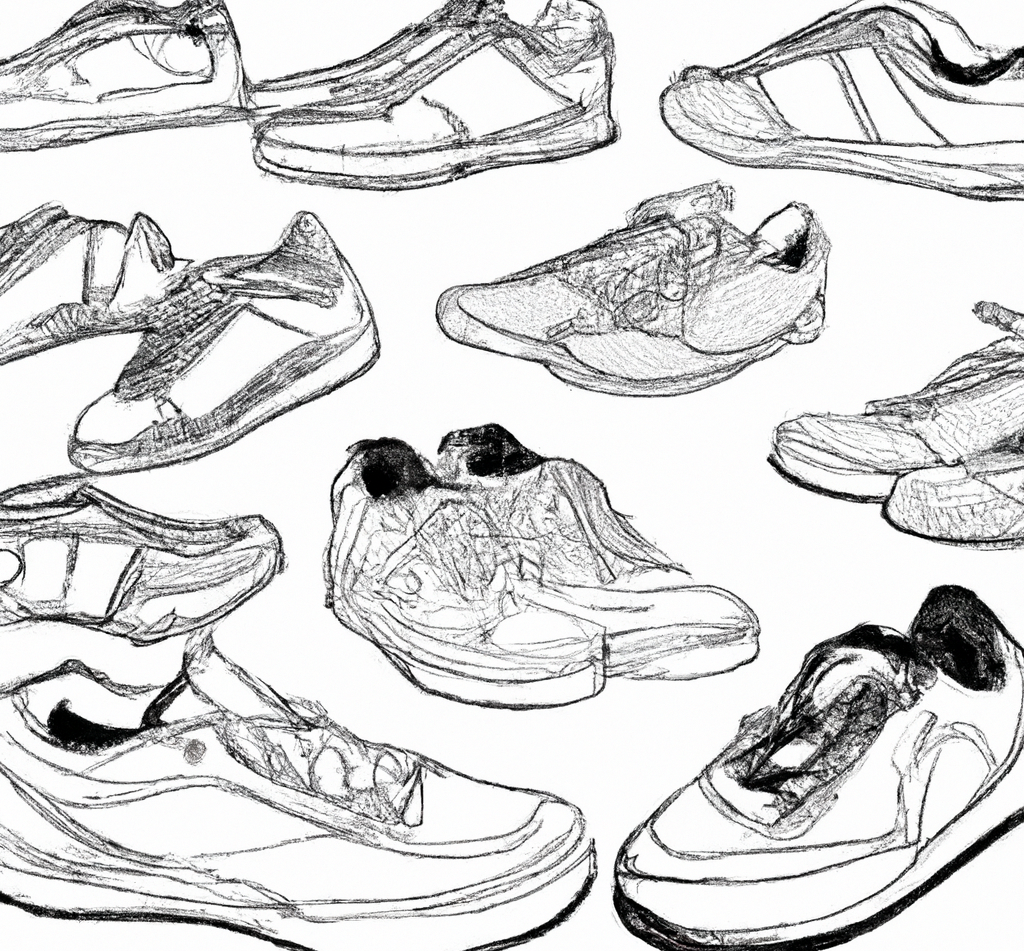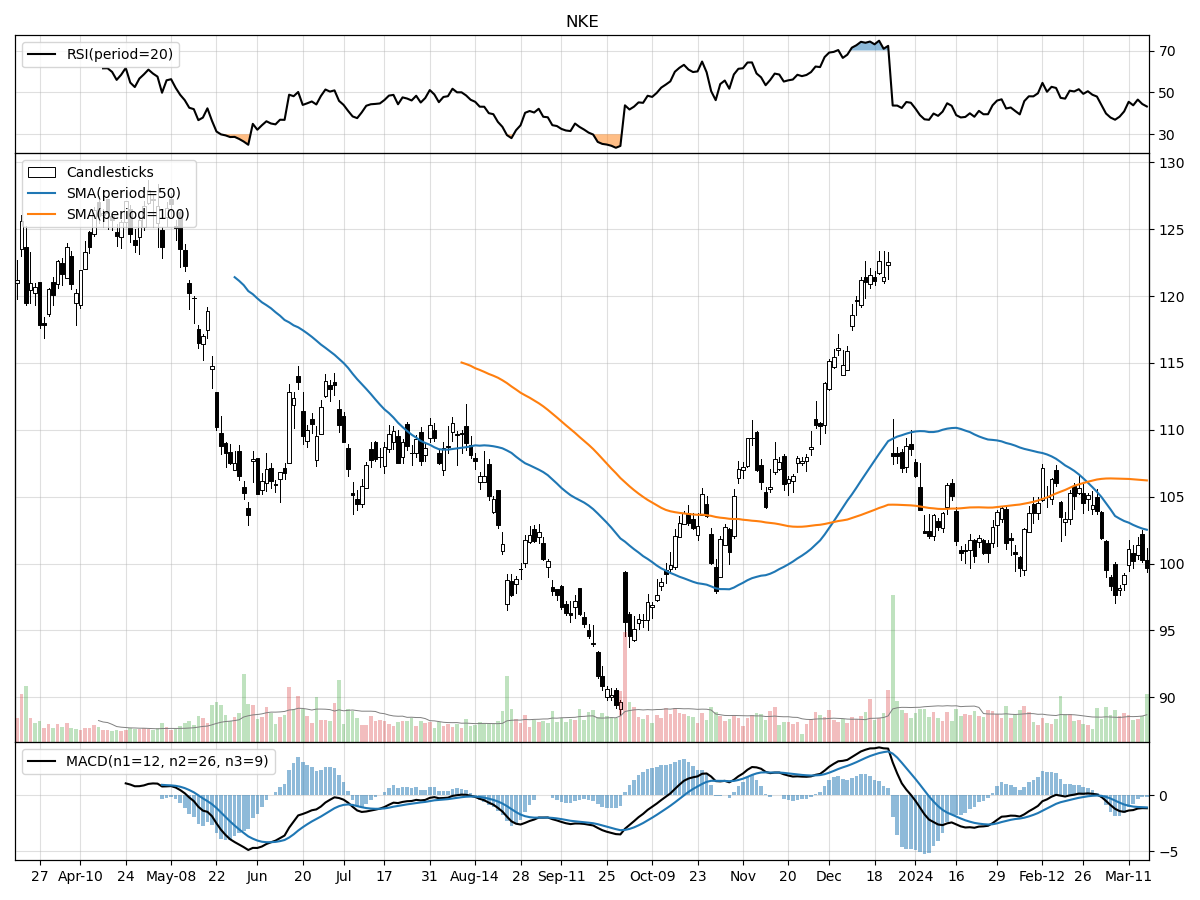Nike Inc. (NKE), Large Cap AI Study of the Week

March 19, 2024
Weekly AI Pick from the S&P 500
Company Overview
NIKE, Inc. is a prominent player in the global athletic footwear, apparel, and equipment market, with its inception dating back to 1967. The company has built a strong brand presence through the NIKE, Jordan, and Converse brands, offering a wide range of products for men, women, and kids. Sales are conducted through both NIKE Direct channels, including physical and digital platforms, and through a network of retail accounts, independent distributors, and licensees across the globe. A significant share of NIKE's revenue, around 43%, comes from the U.S. market, with international sales accounting for the remaining 57%. The company experiences peak revenues during the first and fourth fiscal quarters.
NIKE places a high value on innovation, investing in research and development to create advanced technologies like Nike Air and Flyknit. This commitment to innovation involves collaborations with experts across various fields, including biomechanics and sustainability, to enhance product performance and reduce environmental impact. Manufacturing is primarily conducted by independent contractors, mainly in Vietnam, Indonesia, and China, with the company navigating supply chain and inflationary challenges effectively in fiscal 2023.
The company operates in a highly competitive industry, contending with rapid changes in technology and consumer preferences. It maintains a competitive edge through product quality, innovation, brand engagement, and effective sourcing and distribution, while also protecting its extensive intellectual property portfolio. NIKE's corporate culture is centered on diversity, equity, and inclusion, with various initiatives aimed at developing a diverse workforce that mirrors its consumer base. These efforts are seen as vital for fostering innovation and creativity.
As of May 31, 2023, NIKE employed approximately 83,700 people worldwide and was not significantly affected by labor disputes, adhering to local collective bargaining agreements where necessary. The company is focused on achieving its diversity and inclusion goals by 2025, with strategies in place to enhance recruitment and foster a supportive internal culture. Employee well-being is also a priority, with benefits such as competitive salaries, bonus plans, family care benefits, and well-being initiatives. The leadership team is headed by Mark G. Parker as Executive Chairman and John J. Donahoe II as President and CEO. All corporate information and SEC filings are accessible through NIKE's corporate website.
By the Numbers
Certainly, here's a numerical assessment of the key figures and changes from the annual and quarterly reports:
Annual 10-K Report for Fiscal 2023:
- Revenue increased by 10% to $51.2 billion.
- Currency-neutral revenue growth was 16%.
- Gross margin contracted from 46.0% to 43.5%.
- Income before taxes reduced by over $1 billion due to foreign currency fluctuations.
- Non-GAAP EBIT fell to $6.2 billion from $6.9 billion.
- Return on Invested Capital (ROIC) decreased from 46.5% to 31.5%.
- Net income declined by 16%.
- Diluted earnings per share declined by 14%.
- NIKE Direct revenues climbed to $21.3 billion, a 24% increase in digital sales.
- Selling and administrative expenses rose by 11%.
- Effective tax rate increased to 18.2% from 9.1%.
- North America revenue grew by 18%; Greater China reported revenue declined by 4%.
- North America EBIT increased by 7%; Greater China EBIT decreased by 3%.
- APLA region revenue increased by 17% on a currency-neutral basis, EBIT rose by 2%.
- Global Brand Divisions revenue dropped by 43%; loss before interest and taxes increased by 14%.
- Converse revenues increased by 3% to $2.4 billion.
- Corporate segment loss before interest and taxes increased by 28% to $2.8 billion.
Quarterly 10-Q Report for Q2 Fiscal 2024:
- Revenue increased by 1% to $13.4 billion.
- NIKE Direct revenues grew by 6% to $5.7 billion.
- Gross margin improved by 170 basis points to 44.6%.
- Inventory levels decreased by 6% to $8 billion.
- Shareholder returns of $1.7 billion through buybacks and dividends.
- Anticipated restructuring charges of $400-450 million.
- EBIT margin stood at 14.2% for the quarter.
- Currency-neutral revenues decreased by 1%.
- Footwear revenue remained flat when adjusted for currency.
- Gross profit increased by 5% for the quarter and 3% over six months.
- Selling and administrative expenses increased slightly.
- Effective tax rate decreased due to a reduction in accrued withholding taxes.
- Wholesale revenues declined; NIKE Direct sales grew by 3% in Q2 and 5% over six months.
- Footwear revenues decreased by 5% on a currency-neutral basis.
- EBIT increased by 2% to 3% across different reporting periods.
- EMEA EBIT decreased by 6%.
- Greater China revenue increased by 8% on a currency-neutral basis.
- NIKE Direct revenues in other segments decreased by 4%.
- APLA segment revenue increased by 10% on a currency-neutral basis for the quarter.
- Global Brand Divisions revenue decreased by 33% and 22% for the three and six months period, respectively, with a 5% EBIT decrease over the first half of fiscal 2024.
Stock Performance and Technical Analysis

Based on the technical indicators provided, the stock exhibits mixed signals with some cautionary traits suggesting potential weakness ahead. The current stock price is 11% above its 52-week low, which indicates that the stock has some degree of positive momentum or has recently seen a bounce off its yearly lows. However, being 22% below its 52-week high shows that the stock has retreated significantly from its peak, indicating a bearish trend or a substantial correction.
The daily trading volume is slightly above the longer-term average, which could suggest increased investor interest or heightened activity in the stock. However, the fact that the price has remained relatively stable over the last month while experiencing an 18.75% drop in the last three months indicates that while the immediate volatility has subsided, the medium-term trend is negative.
The Money Flow indicators pointing to heavy selling pressure and distribution are red flags. This implies that there is a greater propensity for selling the stock, which could be indicative of institutional investors exiting their positions or a general lack of confidence in the stock's near-term prospects. The bearish MACD (Moving Average Convergence Divergence) value of -1.09 further supports this view, as it suggests that the stock's short-term momentum is weaker than its long-term momentum and that the stock may continue its downward trajectory.
Overall, these technical indicators suggest that investors should approach the stock with caution. The bearish MACD, distribution signals from Money Flow indicators, and the significant drop from the 52-week high could be interpreted as signs of an ongoing downtrend or at least a lack of positive catalysts in the near term. It would be prudent for investors to seek additional fundamental analysis, consider market conditions, and monitor any potential changes in the stock's trading pattern before making an investment decision.

The ‘Bull’ Perspective
Title: Why NIKE, Inc. (NKE) Stock Is a Strong Buy: A Comprehensive Analysis
Summary:
- Resilient Revenue Growth: NIKE has shown a consistent increase in revenues, with a recent 1% year-over-year growth to $13.4 billion, and a significant 6% increase in NIKE Direct revenues to $5.7 billion.
- Expanding Gross Margins: The company's gross margin has impressively expanded by 170 basis points to 44.6%, indicating efficient cost management and pricing strategies.
- Strong Digital Sales and Direct-to-Consumer Focus: NIKE Direct continues to thrive with a 1% increase in digital sales and the opening of new stores, demonstrating the brand's successful pivot to a direct-to-consumer model.
- Shareholder Value Enhancement: NIKE's commitment to enhancing shareholder value is evident through the distribution of $1.7 billion via buybacks and dividends.
- Strategic Positioning Amidst Economic Headwinds: Despite global economic uncertainties and the recent banking sector turmoil, NIKE's strategic initiatives position it well to navigate challenges and capitalize on a recovering market.
Elaboration:
- Resilient Revenue Growth
NIKE's ability to generate a steady increase in revenue amidst a challenging economic climate is commendable. The modest 1% year-over-year growth may seem small, but it's significant given the broader context of cautious consumer spending. The 6% growth in NIKE Direct revenues, contributing to 45% of total brand revenues, is a testament to the strength of NIKE's brand and its direct-to-consumer capabilities. This growth is particularly noteworthy considering the 6% decrease in inventory levels to $8 billion, which reflects NIKE's adept inventory management in a period of supply chain disruptions. - Expanding Gross Margins
The expansion of gross margins by 170 basis points to a robust 44.6% cannot be overlooked. This improvement is a direct result of strategic pricing decisions and reduced freight costs. While the company did face higher product input costs and unfavorable currency exchange rates, the positive impact on gross margins highlights NIKE's effective cost control measures. The ability to maintain and grow margins in such an environment is indicative of a strong operational foundation that is likely to support future profitability. - Strong Digital Sales and Direct-to-Consumer Focus
NIKE's focus on digital sales and direct-to-consumer channels is paying off. The reported 1% increase in digital sales and the expansion of physical retail stores underline the company's commitment to meeting consumers where they are. NIKE Direct's growth is a clear signal that the brand is successfully adapting to the evolving retail landscape where digital presence and personalized consumer experiences are paramount. As the digital economy continues to grow, NIKE's investments in this area position it to capture a greater market share. - Shareholder Value Enhancement
The distribution of $1.7 billion in buybacks and dividends is a strong indicator of NIKE's financial health and its prioritization of shareholder returns. This level of capital return to shareholders reflects confidence in the company's cash flow generation and its long-term growth prospects. In an environment where many companies are cutting back on dividends and share repurchases, NIKE's ability to continue these programs is a bullish signal for investors. - Strategic Positioning Amidst Economic Headwinds
In the face of economic headwinds, including the recent banking sector upheaval and lingering inflation concerns, NIKE's strategic positioning is crucial. The company's focus on direct-to-consumer sales, digital expansion, and inventory management allows it to remain agile and responsive to market changes. Moreover, the growth in the S&P 500 Index to new all-time highs in 2024 suggests a recovering market environment in which NIKE's strong brand and strategic initiatives can drive further growth. The company's resilience in navigating past challenges, such as the COVID-19 pandemic, demonstrates its ability to adapt and thrive even in uncertain times.
Conclusion:
NIKE, Inc. (NKE) presents a compelling investment opportunity, grounded in solid financial performance, strategic market positioning, and a commitment to returning value to shareholders. The company's resilience in the face of macroeconomic challenges and its proactive approach to growth through digital and direct-to-consumer channels make it a standout in the athletic apparel and footwear industry. Investors looking for a robust and forward-thinking company would do well to consider NIKE as a key addition to their portfolios.

The ‘Bear’ Perspective
Bearish Outlook on Nike, Inc. (NKE): A Case for Caution
Summary:
- Revenue Growth Stagnation: Nike's recent 1% year-over-year revenue growth indicates a potential plateau in sales, raising concerns about market saturation and future profitability.
- Inventory Management Challenges: A 6% decrease in inventory levels may signal inefficiencies in supply chain management, possibly leading to stockouts or overproduction in subsequent quarters.
- Margin Pressures: Despite a 170 basis point increase in gross margin, Nike faces continued margin pressures from higher product costs and unfavorable currency exchange rates, which could erode profitability.
- Digital Sales Slowdown: The modest 1% increase in digital sales suggests a slowdown in what should be a high-growth area, potentially impacting overall revenue growth and direct-to-consumer strategy success.
- Geopolitical and Economic Uncertainties: Ongoing geopolitical tensions and economic headwinds, including inflation and interest rate hikes, could negatively impact consumer spending and Nike's international operations.
Elaboration:
- Revenue Growth Stagnation:
Nike's latest financials show a mere 1% increase in revenue, which could be an early sign of growth challenges ahead. For a company that investors have long prized for its ability to consistently deliver top-line expansion, this stagnation is worrisome. It could indicate that the market for athletic apparel and footwear is becoming saturated, or that competitors are chipping away at Nike's dominant position. With the stock market pricing in growth expectations, any indication of a slowdown might not sit well with shareholders, potentially leading to a re-rating of the stock. - Inventory Management Challenges:
The 6% decrease in inventory levels reported by Nike may seem positive at first glance, as it suggests the company is not overstocked. However, this figure could also hint at underlying issues in forecasting demand, which could lead to missed sales opportunities if inventory is too low to meet consumer demand. Alternatively, it might signal overcorrection, which could result in excess inventory in future periods if sales forecasts are overly optimistic. Efficient inventory management is critical for maintaining healthy margins and avoiding write-downs, which can significantly impact financial performance. - Margin Pressures:
Although gross margin has improved, Nike is not immune to the cost pressures affecting the global economy. The company has acknowledged the impact of higher product costs and unfavorable currency exchange rates, which have collectively reduced the gross margin by 110 basis points. These pressures are likely to persist, especially with ongoing supply chain disruptions and inflationary challenges. If Nike is unable to offset these costs through price increases or cost-cutting measures, its profitability could take a hit, which would be detrimental to shareholder value. - Digital Sales Slowdown:
In an era where e-commerce is king, Nike's modest 1% growth in digital sales is a red flag. Digital channels are typically high-margin and lower-cost compared to brick-and-mortar stores, so any slowdown in this segment is particularly concerning. It could suggest that Nike's digital initiatives are not resonating with consumers as expected, or that competition in the online space is heating up. As the company continues to invest heavily in its digital transformation, shareholders will expect to see a significant return on these investments, and any shortfall could lead to disappointment. - Geopolitical and Economic Uncertainties:
Nike operates on a global scale, which exposes it to a myriad of geopolitical and economic risks. The recent Silicon Valley Bank collapse and subsequent banking concerns, although short-lived, have shown how quickly financial conditions can change. Moreover, high inflation and the Federal Reserve's interest rate hikes could dampen consumer spending, particularly on discretionary items like sportswear. Internationally, currency fluctuations can erode foreign earnings, and geopolitical tensions could disrupt Nike's supply chains or affect its sales in key markets. These uncertainties add a layer of risk to Nike's future performance and could lead to volatility in the stock price.
In conclusion, while Nike remains a leader in its industry, the company is facing a confluence of challenges that could impede its growth and profitability. As an investment advisor with a bearish perspective, I would advise clients to exercise caution with Nike's stock. The current economic climate, combined with the company's recent performance and potential headwinds, suggests that there may be better opportunities elsewhere in the market. Investors should carefully consider these factors and their risk tolerance before making any investment decisions regarding Nike, Inc.




Comments ()